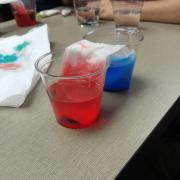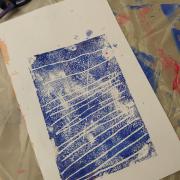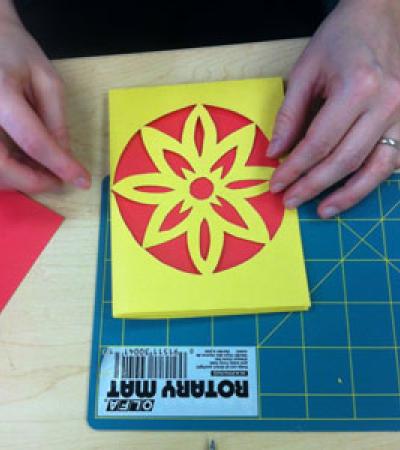Library for All is a monthly, systemwide, interactive program that welcomes adults with disabilities to make crafts, create art, play games and explore the library. Each program is tailored to the audience’s unique interests and ability levels. The programs encourage the DIY spirit, and each participant has the opportunity to make and take something.
Library for All occurs once a month at four JCPL locations and lasts for 90 minutes. We offer more low-key activities like adult coloring and Keva Planks, as well as interactive options like DIY crafts and science- or technology-based experiments.
Advanced Planning
The goal of Library for All is to offer impactful and fun library experiences for an underserved population in our community. Day groups for adults with disabilities were already visiting the library on a regular basis, but they were not experiencing everything the library had to offer, including many of the makerspace and hands-on activities offered to other patrons.
About a month before the first program, we put together a list of potential programming ideas that would revolve around our DIYLab/Makerspace tools (3D printers, sewing machines, button maker, photo scanner, silhouette cutter etc...), since all of these activities could be modified for use at many levels or used for doing demonstrations. I also listed some passive ideas - such as a library tour, listening to music/sing-a-longs, guest speakers, story-telling, giant board games, and adult coloring - and reached out to the day group coordinators asking if their clients would be interested in attending monthly DIY programs at the library. I originally reached out to three organizations, but only one responded. I learned quickly that while connecting with the caregivers who were bringing the groups into the building was a great way to gage interest, I needed to take the next step and contact the actual events coordinators in order to get the program on their social calendar. Once I did this, their response was enthusiastic, and the feedback on our program ideas was invaluable. From the start, we really wanted our programs to reflect the participants’ interests as much as possible in order to ensure a positive and impactful experience for them. (View a list of activities under Attachments at right.)
Before the first program, we informed library staff about the goals of the program and the stages of the program-planning process. We distributed People First Language documents to all staff and reached out to interested staff to assist with the programs. (View examples of People First Language under Attachments at right.)
To plan for each Library for All program, I created a monthly outline for myself and I add or subtract based on feedback, new ideas, supplies, and suggestions from participants. I always attempt the projects/crafts a few weeks in advance to track how many steps it will take. Doing this also informs me on how I may need to modify based on ability levels. To find activities for each month's programs, I generally look for makerspace or S.T.E.A.M. projects online, and then modify them to work for our program.
We require registration for each Library for All program, and there is an expectation that caregivers remain present throughout the program. Our software requires that registrants list the number of participants and the number of caregivers. Registration opens up a month in advance.
Marketing
Our first step was reaching out in person to the local day groups already using the library. Next, we researched other local groups - including our local Developmental Disabilities Resource Center, Metro Care Providers Network (a service that provides health services to low income community members), County Behavioral Health Center, Jefferson County Public Health specializing in families with disabilities, as well as local support groups for caregivers of people with disabilities, and Jefferson County Human Services. I reached out to each of these groups through phone calls and email. This one-on-one marketing generated regular attendance for the first few months at the Golden Public Library.
Eventually, Library for All was officially added to the Jefferson County Public Library (JCPL) website and event calendar. It was also highlighted on our website with a blog post. Official JCPL marketing, along with marketing on local social media pages, helped to promote the programs to the entire community. Once the official marketing was enacted, we received numerous inquiries, and our number of participants increased. As interest developed, other JCPL branches signed on to offer Library for All monthly programs, with great success. (View an e-flier under Attachments at right.)
A Denver Post reporter reached out to us and wrote a story on Library for All. They interviewed the librarians involved in its inception as well as the JCPL special populations coordinator. This was very exciting as it generated additional interest in the program.
Budgeting
These programs do not need to be expensive — my branch plans to spend around $100 annually for this program, with most of the costs incurred with the make-and-take crafts.
In preparing our schedule for the year, we first make lists of the materials that are already available to us, and then put great effort into designing the programs to include those materials. Beyond that, we look for upcycling opportunities, then finally we focus in on the activities that would require a budget.
There are numerous options for dollar store crafts and S.T.E.A.M. projects that are of interest to adults. You can offer many exciting experiments that use just baking soda and vinegar, for example. We use many of our own materials or borrow craft supplies from the library, and have also tapped community volunteers (such as local storytellers).
We have also borrowed from our library system’s programming inventory, using such items as Keva Planks, a button-maker and circuits. To keep costs low, consider incorporating passive programs and/or activities that are already happening in your library, such as adult coloring and puzzles. The interaction and conversation seems to be just as important as the crafts themselves.
Day-of-event Activity
We allow 30 minutes for setting up the programming room. The tables are organized to accommodate the number of people attending, and then the room is divided into four areas: DIY Crafts, S.T.E.A.M. experiments, building opportunities (such as LEGO or Keva Planks) and adult coloring.
We noticed after the first few programs that some returning participants preferred the structure of having the same room set-up and activities each time. So while we offer different activities at the DIY Crafts and S.T.E.A.M experiments areas each month, the adult coloring activities and Keva Planks are always available.
Two staff members are in the room at all times. Since we are not equipped to offer respite care we require that caregivers be in the room as well.
We do prep work to help the program run smoothly and to avoid unneeded frustrations for the participants. For example, when we did our DIY hand warmers program, we sewed up three sides of the hand warmer and measured out the amount of rice needed ahead of time. Participants used funnels to fill their hand warmers and then used the sewing machine to sew up the final side. This helped to ensure that everyone had an opportunity to use the sewing machine within the time allotted.
Program Execution
We generally have 15 to 25 people participating in the program each month at our branch. This number works well for the programming space we have. While numbers are great for evaluating the success of the program, we also wanted these programs to be highly effectual and meaningful for the participants. Smaller groups allow for personal interaction as well as personal assistance with our library’s DIYLab tools.
The feedback we have received from participants and caretakers has been encouraging and positive. We have been told that the participants look forward to coming back each month. The level of participation each month is strong, and the participants seem to be engaged by what we offer. (View images of some of the activities under Photo Slideshow at right.)
We asked for feedback directly from the caretakers and program coordinators and took their advice regarding what their clients would enjoy and, more importantly, what they would not enjoy. We also ask them every month to suggest ideas for future program topics or activities.They asked us for science experiments, so the next month we added a science experiment component, and these have been a huge hit. Other program evaluation questions we ask after each Library for All event include:
- What did you enjoy the most about the program today?
- How well did this program suit the needs of your clients? Are we duplicating activities that you are already doing throughout the month?
- Was there anything about the program that you would change? Is there anything you would like to see added?
- Did you have fun?
Due to high interest in free programming for adults with disabilities in the community and the excitement generated by our program, it is now being offered in three additional branches throughout JCPL. One of those branches had 45 participants at their first event.
These successes signaled to us that we are on the right track and that providing impactful library programs for adults with disabilities was a gap that is now being filled in our community. A program coordinator for one of the day groups that attend Library for All programs said that she did not know of any other place where her clients could have access to maker tools. This was really important to us in regard to the design of the programs
Advice
We recommend that you tailor your program topics to suit the interests of the patrons who are participating. It is important to develop relationships with caretakers and participants as well as observe what works and what does not.
When planning program activities, we focus on the DIY spirit and adjust the craft accordingly. For example, during our hand warmer craft, one participant with limited sight and dexterity was able to use the sewing machine and make something useful for himself with our assistance.
Outreach is vital to making these programs a success. When interviewed about Library for All, a program coordinator who brings her clients to the library said, “I think it’s a great program, a great way for our clients to be involved in the community .... I think it’s helped them feel more confident and comfortable, just having those supportive community members. They reached out to us and that rarely happens. They welcomed us with open arms.”
Supporting Materials
- Feedback (Coming Soon!)
- Programming Librarian Facebook Group






